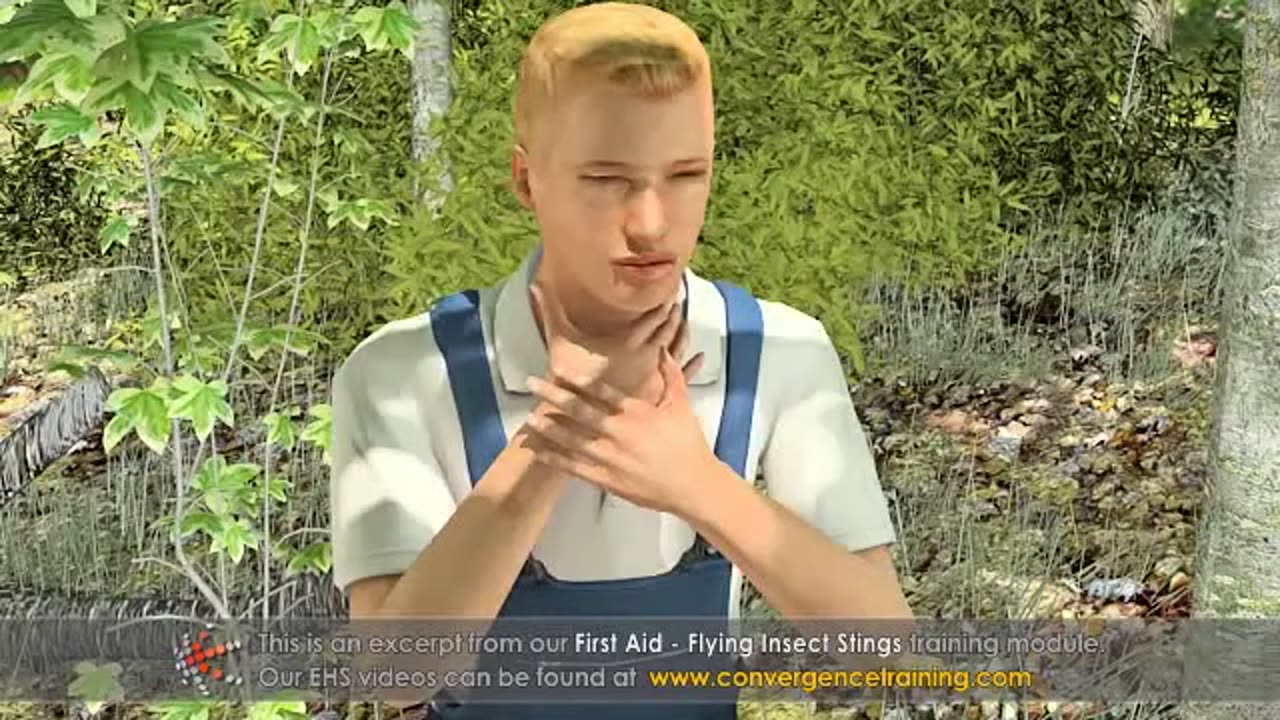Premium Only Content

First Aid - Flying Insect Stings Training
### **First Aid Training for Flying Insect Stings**
This training provides participants with knowledge on how to recognize, respond to, and treat stings from flying insects such as bees, wasps, hornets, and others. It also includes strategies for preventing stings and knowing when to seek medical assistance.
---
### **1. Introduction to Flying Insect Stings**
- **Why This Training is Important**
- Stings can cause pain, allergic reactions, and, in severe cases, life-threatening anaphylaxis.
- Common workplace and outdoor risks.
- **Types of Flying Insects**
- Bees, wasps, hornets, yellow jackets, and other stinging insects.
- Differences in behavior and sting mechanisms:
- Bees can sting once, leaving a stinger.
- Wasps and hornets can sting multiple times.
---
### **2. Recognizing Stings and Symptoms**
- **Local Reactions**
- Pain, redness, and swelling at the sting site.
- Warmth or itching.
- **Moderate Reactions**
- Larger swelling extending beyond the sting site.
- Mild nausea or fatigue.
- **Severe Reactions (Anaphylaxis)**
- Difficulty breathing or wheezing.
- Swelling of the face, lips, or throat.
- Rapid heartbeat or dizziness.
- Hives or widespread rash.
---
### **3. Immediate First Aid for Stings**
- **For Mild to Moderate Reactions**:
1. **Remove the Stinger** (if present):
- Scrape it off gently using a flat edge (e.g., credit card).
- Avoid pinching or squeezing to prevent injecting more venom.
2. **Clean the Area**:
- Wash with soap and water to prevent infection.
3. **Apply a Cold Pack**:
- Use ice wrapped in a cloth to reduce swelling and pain.
4. **Relieve Discomfort**:
- Use over-the-counter antihistamines, pain relievers, or anti-itch creams.
- **For Severe Reactions**:
1. Call **Emergency Services (911)** immediately.
2. Administer an **Epinephrine Auto-Injector** (if available and prescribed).
3. Keep the person calm and lying down.
4. Monitor for signs of shock (e.g., pale skin, confusion) and provide CPR if necessary.
---
### **4. Medical Treatment**
- **When to Seek Medical Attention**
- Multiple stings or stings inside the mouth or throat.
- Severe or rapidly worsening symptoms.
- Stings in high-risk individuals (e.g., children, elderly, those with known allergies).
- **Hospital Care**
- Treatment for anaphylaxis (epinephrine, oxygen, IV fluids).
- Pain management or infection prevention.
---
### **5. Preventing Flying Insect Stings**
- **At Work and Home**
- Avoid strong scents (perfumes, sugary drinks, brightly colored clothing).
- Keep food and trash covered outdoors.
- Repair screens, seal cracks, and remove nests promptly (using professionals if needed).
- **In the Outdoors**
- Wear protective clothing (long sleeves, pants).
- Avoid disturbing nests or swatting at insects.
- Be cautious when eating or drinking outdoors.
---
### **6. Handling Swarms or Multiple Stings**
- **Escape Safely**
- Cover your face and run to a safe area (preferably indoors).
- Avoid jumping into water (insects may wait above the surface).
- **Treating Multiple Stings**
- Remove stingers carefully and monitor for systemic reactions.
- Apply cold compresses to multiple sting sites.
---
### **7. Special Considerations**
- **Known Allergies**
- Importance of carrying epinephrine auto-injectors (e.g., EpiPen).
- Educating coworkers and family on how to use an auto-injector.
- **Stings Near Sensitive Areas**
- Stings on the face, mouth, or throat require immediate medical attention due to airway risks.
---
### **8. Hands-On Activities**
- **Simulated First Aid**
- Practice removing stingers and applying cold packs.
- **Role-Playing Emergency Scenarios**
- Using epinephrine auto-injectors in a safe, controlled environment.
- **Preventive Measures**
- Identifying and mitigating risks in various environments.
---
### **9. Conclusion**
- **Key Takeaways**
- Recognize symptoms and act quickly, especially for severe reactions.
- Mild stings can be treated at home, but anaphylaxis is a medical emergency.
- Prevention is critical to avoid stings and their consequences.
- **Resources**
- Employer policies on first aid and emergency response.
- Information on local insect species and their habitats.
- **Q&A Session**
---
### Supporting Materials
Would you like:
- A **training guide** or **presentation slides**?
- Printable **first aid checklists** for insect stings?
- Custom **scenarios for practice** or emergency response drills?
- Certifications or **quizzes** for participants?
Let me know how I can assist further!
-
 20:24
20:24
HSESafetyInformation
7 months agoKABULI PULAO RECIPE - Original 40+ KG Afghani Meat Pulau Prepared - Street Food Qabili Plav Recipe_2
35 -
 1:59:53
1:59:53
Game On!
18 hours ago $1.33 earnedCollege Football SHOWDOWN! Week 5 EARLY Preview!
31.8K2 -
 9:26
9:26
Millionaire Mentor
17 hours agoMegyn Kelly STUNNED as Tucker Carlson Reveals The Truth About Charlie Kirk
60.9K29 -
 7:30
7:30
Blackstone Griddles
14 hours agoEasy Weeknight Meals: Meatloaf Sliders on the Blackstone Griddle
21.3K7 -
 8:47
8:47
DropItLikeItsScott
16 hours ago $2.28 earnedDid HI-POINT Just Create The Next Best AR? Hi-Point HP15 AR-15 Pistol
19.8K1 -
 39:19
39:19
The Heidi St. John Podcast
3 days agoFirst Fan Mail Friday: From the White House to Your Questions
21.9K5 -
 2:01:37
2:01:37
BEK TV
1 day agoTrent Loos in the Morning - 9/23/2025
20.5K2 -
 24:12
24:12
Michael Feyrer Jr
1 day agoWe Stream to TikTok! How we did it! Week 2 #Stream10k
20K2 -
 35:33
35:33
Anthony Rogers
18 hours agoBourbon and Beyond (2025)
16.3K1 -
 33:30
33:30
The Bryce Eddy Show
4 days ago $0.42 earnedMonty Bennett: HERO Model to Fight Crime
22.7K3